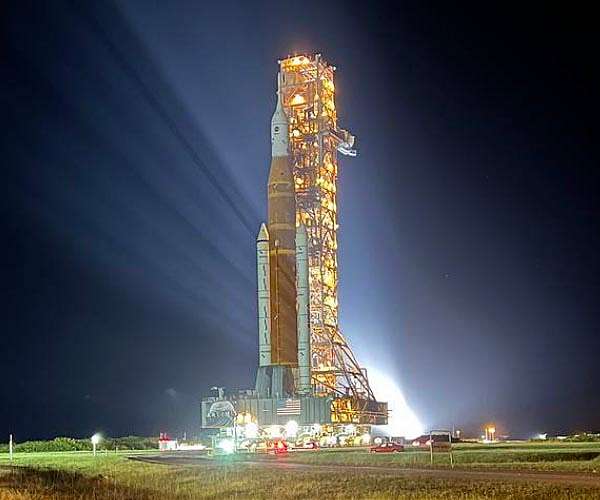
NASA rolls Artemis I mission rocket back to launch pad ahead of Nov. 14 launch (Image Credit: Space Daily)
NASA is making another run at launching the Artemis I spacecraft on its maiden voyage to the moon, rolling the $4.1 billion rocket back onto the launch pad Thursday at Kennedy Space Center after months of delays pushed the liftoff to Nov. 14.
The launch is scheduled a week from Monday at 12:07 a.m., but NASA was keeping an eye on a low-pressure system in the Caribbean that threatened to bring heavy rain and strong winds to the area in the coming days.
The agency still has about 10 days for a contingency plan if conditions worsen, although the rocket is built to withstand moderately strong weather.
Mission controllers considered the storm to be a very low threat and expressed confidence in their decision to move forward.
“I think everyone feels really good about the launch,” said Jim Free, associate administrator of the Exploration Systems Development Mission Directorate at NASA headquarters in Washington. “If we weren’t confident, we wouldn’t roll out. If we weren’t confident, we wouldn’t start the countdown when we do so. We’re confident moving forward.”
Late Thursday night, crews began moving the nearly 3,000-ton Space Launch System rocket and Orion spacecraft from the Vehicle Assembly Building back to launch pad 39B, some 4 miles away. By Friday morning, the rocket was in place.
The unmanned Artemis I mission has been dogged by several malfunctions, including fuel leaks and engine-related problems before NASA put the ship back into storage in late September just days before Hurricane Ian came ashore.
The first launch attempt on Aug. 29 was canceled due to a fuel leak and a bad sensor on one of the main engines. The next launch attempt on Sept. 3 was scrubbed due to a fuel leak that NASA has since repaired.
The agency next eyed a launch window between Sept. 19 and Oct. 4, but the approaching storm nixed that plan as well.
NASA chose to wait out the next launch window that expired on Halloween, taking the extra time to conduct routine maintenance and ensure all flight systems are working as expected.
The upcoming Nov. 12-27 launch window, like previous timeframes, is determined by the cycles of the Earth and moon as they need to be in just the right tandem for the encounter.
The Artemis I mission sets the stage for astronauts to return to the lunar surface for the first time since 1972, which will happen sometime in 2025 or 2026 as part of the Artemis 3 mission.
For now, Artemis I will fly more than a half-million miles to the moon and back over 42 days while testing the limits of the Orion crew module and its Space Launch System rockets.
Next year, astronauts will be aboard the Artemis 2 capsule, which will circle the Earth and moon in the mission’s first manned test flight.
Related Links
Rocket Science News at Space-Travel.Com
|
|
Tweet |
|
|
|
We need your help. The SpaceDaily news network continues to grow but revenues have never been harder to maintain. With the rise of Ad Blockers, and Facebook – our traditional revenue sources via quality network advertising continues to decline. And unlike so many other news sites, we don’t have a paywall – with those annoying usernames and passwords. Our news coverage takes time and effort to publish 365 days a year. If you find our news sites informative and useful then please consider becoming a regular supporter or for now make a one off contribution. |
||
|
SpaceDaily Monthly Supporter $5+ Billed Monthly |
SpaceDaily Contributor $5 Billed Once credit card or paypal |
|
Arianegroup to develop Phoebus for ESA to demonstrate future Ariane 6 Carbon Upper Stage
Paris (ESA) Nov 03, 2022
ArianeGroup has received a 50-million-euro agreement from the European Space Agency (ESA) to continue the development of PHOEBUS, a super-light carbon composite upper stage demonstrator. This work will enable development of the next Ariane6 upper stage, by raising the maturity level of cryogenic composite technologies.
The objective is to reduce the weight of the upper stage by using carbon fibre instead of metal for structures such as tanks.
PHOEBUS (Prototype for a Highly OptimizEd Black U … read more








